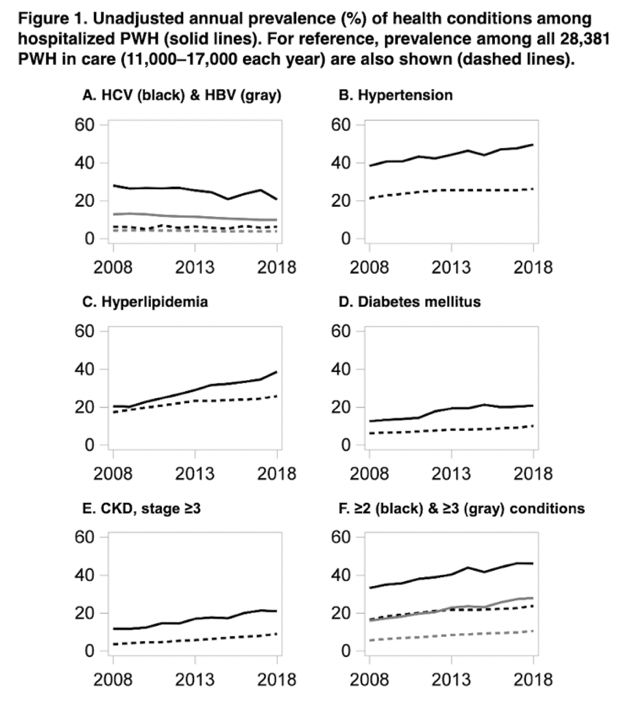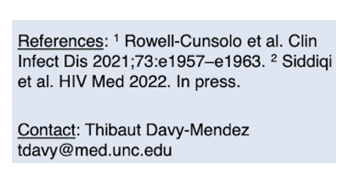 |
 |
 |
| |
Comorbidity Rate Rose 1% to 2% Yearly in 2008-2018 for HIV+ in Hospital
|
| |
| |
Integrase Inhibitor in First ART Poses Some Cardio Risk in Big US Analysis
AIDS 2022, July 29-August 2, Montreal
Mark Mascolini
Prevalence of certain comorbidities in hospital patients with HIV rose 1% to 2% yearly from 2008 to 2018, except for HCV and HBV, according to a 6785-person analysis in the United States and Canada [1]. Aging of the in-hospital HIV population over that decade did not fully explain the climbing comorbidity rate.
Non-AIDS conditions now cause most hospital admissions of people with HIV, according to NA-ACCORD cohort researchers who conducted this study. Because they believe relying on discharge diagnoses to track comorbidities results in underestimates of their prevalence, they figured non-AIDS comorbidity prevalence for in-hospital patients with HIV by analyzing longitudinal clinical data.
The study group consisted of 6785 people with HIV from five NA-ACCORD cohorts with 1 or more hospital admissions per year for the period 2008-2018. The investigators determined the annual prevalence of each condition of interest then estimated age-adjusted prevalence trends using linear-risk models with generalized estimating equations. Comorbidities analyzed were HBV infection, HCV infection, hypertension, hyperlipidemia, diabetes mellitus, and stage 3 or worse chronic kidney disease (CKD).
In the years 2008 and 2018, cisgender men made up 71% and 76% of the in-hospital HIV populations, blacks 42% and 42%, whites 38% and 38%, Hispanics 11% and 15%, men who have sex with men 36% and 43%, drug injectors 27% and 18%, and heterosexuals or others 37% and 39%. Median age stood at 47 in 2008 and 54 in 2018, median CD4 count at 294 and 463, proportions with a viral load below 200 copies at 47% and 77%, and proportion with prior AIDS at 42% and 39%.
Unadjusted change in absolute prevalence per year for each comorbidity indicated that HBV prevalence per year stayed the same over the study period (0.00% change) and HCV prevalence per year fell (-0.57%). Unadjusted change in per-year prevalence for all other conditions rose 1% or more for each condition: hypertension 0.99%, hyperlipidemia 1.81%, diabetes 0.96%, CKD 1.05%. Unadjusted per-year change in prevalence of 2 or more conditions rose 1.34% and of 3 or more conditions 1.21%.
Age-adjusted analysis showed that change in per-year prevalence of HBV infection stayed the same as in the unadjusted analysis (-0.01%), while the per-year drop in HCV infection got steeper (-0.72%). Age adjustment trimmed the change in per-year prevalence of the other conditions, but prevalence of all other conditions except hypertension (0.01% yearly change) still rose year to year: hyperlipidemia 0.42%, diabetes 0.35%, CKD 0.36%, 2 or more conditions 0.24%, and 3 or more conditions 0.21%. Thus aging of the in-hospital HIV population in the US and Canada did not entirely explain climbing prevalence of comorbidities.
The NA-ACCORD team believes their findings “highlight the importance of non-AIDS comorbidity prevention and management in HIV care to prevent hospitalization.” They recommend that hospital discharge planning for people with HIV give more weight to managing chronic non-AIDS diseases.
Reference
1. Davy-Mendez T, Napravnik S, Eron JJ, et al. Increasing non-AIDS comorbidity burden among hospitalized persons with HIV (PWH) in the US and Canada. AIDS 2022, July 29-August 2, Montreal. Abstract EPB101.





|
| |
|
 |
 |
|
|